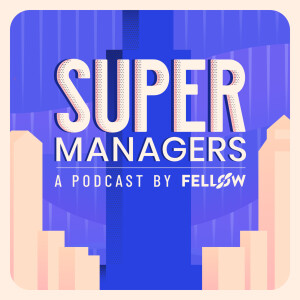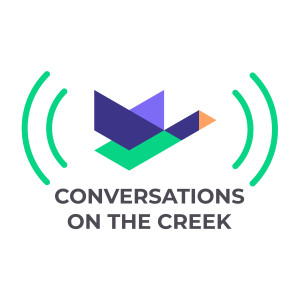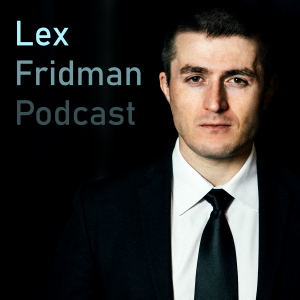

Episode List

AI Lets Every Team Create Marketing-Ready Videos Instantly with Emily Kensley
Content marketer and video lead Emily Kensley (Fellow) walks through a near-zero-friction workflow for creating polished product videos fast. She records clean, auto-animated screen demos with Screen Studio, fixes (or replaces) audio with Podcastle (Magic Dust + AI voices), and drafts scripts by riffing into a Fellow meeting then refining the transcript in ChatGPT. The result: 11-minute, brand-consistent tutorials produced in hours instead of days—repeatable by any team (marketing, CS, product, sales).Timestamps01:19 — Daily use of AI; from occasional to constant over last 6 months01:53 — What you’ll learn: a minimal-human, video-centric content workflow03:41 — Tool #1 intro: Screen Studio for screen recordings05:27 — Live capture of an AI meeting recap demo (click-through highlights, actions, decisions)06:23 — Raw → instant output: auto-smoothing cursor paths & smart zooms (no manual keyframes)07:23 — Host example: using Screen Studio for a Zapier + Fellow automation video07:44 — “Done is better than perfect”: quick crop fixes, branded backgrounds, cursor presets08:24 — Team presets = consistent brand across departments09:44 — Tool #2 intro & story: Podcastle rescues a day of bad mic audio10:59 — Podcastle audio editor: noise reduction, levelling, silence removal12:10 — Magic Dust AI demo: echoey room → studio-quality voice13:38 — AI Voices in Podcastle: when to clone vs. pick a preset (e.g., “Abigail”)16:12 — Long-form scripts → generated narration in minutes; edit/regenerate on typos17:54 — Brand consistency: shared voice so any team can ship VO18:29 — Putting it together: Screen Studio video + Podcastle narration19:24 — Finished example: Fellow YouTube settings walkthrough (11-minute tutorial)21:06 — Syncing visuals to VO: record screen while listening to the generated narration22:59 — Script creation workflow: Fellow call → transcript → ChatGPT → clean script23:34 — Full recap of the end-to-end pipeline25:01 — Repurposing: scripts → blogs, help center, CS clips; scale breadth of tutorials26:28 — Looking ahead: excitement about fast-evolving AI agentsTools & Technologies Mentioned (with quick notes)Screen Studio — Smart screen recorder that auto-smooths mouse movement, adds tasteful zoom/pan animations, and supports brand presets for consistent output.Podcastle — Audio suite used here to edit audio clipsMagic Dust AI: one-click studio-quality enhancement (denoise, de-reverb, leveling).AI Voices & Voice Cloning: generate narration from text; keep brand-consistent VO.Fellow — AI Meeting assistant used to host a solo “idea dump,” generate transcripts, AI recaps, chapters, and action items; doubles as the seed for scripts.ChatGPT — Refines raw Fellow transcript into a clean, concise voiceover script.YouTube — Publishing destination for finished tutorials.Zapier — Example in host’s Screen Studio demo (automation with Fellow).Google Meet / Zoom — Where the solo Fellow “recording” session can happen.Adobe (Premiere/After Effects) — Old manual workflow stand-ins (contrast to auto animations).Subscribe at thisnewway.com to get the step-by-step playbooks, tools, and workflows.

AI Designs Products, Ads & Growth Strategies Faster Than Ever with Eddie Yoon
Eddie Yoon, Sr Director, Paid Media at NP Digital, shows how CMOs can spin up a full creative campaign in ~30 minutes using AI. He breaks down a rapid “three-tab” workflow—Meta Ad Library for competitive research, GPT for strategy and prompts, and an image generator (Reeve) for instant mood boards—then extends it into testing (Trial Reels, TikTok hooks), product R&D, and agentic pipelines. We also riff on why the next decade could normalize solo billionaire founders, how Netflix foreshadowed AI-driven content, and what real-time, stylized, monetizable media will look like.Timestamps1:07 Meet Eddie Yoon—NP Digital, paid social × creative × AI background.1:49 “AI is redefining growth”: blistering company speed and scale.2:16 The solo-founder era & agentic executive teams.4:39 Enterprise example: HubSpot’s leadership going all-in on AI.5:29 Founder example: Tyler at Beehive—shipping fast by listening + acting.6:30 Design & media: Netflix’s early AI play; House of Cards data story.11:29 The 30-minute campaign challenge—Eddie’s live plan.12:53 The three tabs: Meta Ad Library → GPT prompts → Reeve mockups.14:37 Copy/paste every active ad into GPT; ask for strategy synthesis.16:06 Five “board-level” ideas; forcing a single high-acceptance pitch.17:56 Image prompt for “Comfort 2.0” (eco-luxury, performance lifestyle).20:27 Prompting hack: “200+ IQ” to push for originality (avoid clichés).21:06 Locking on Comfort 2.0—“performance tech meets everyday life.”23:06 Iterating the mood board; feeding outputs back into GPT.23:30 If the client has the shoe already: do it all in AI (no photoshoot).24:39 Rapid tests: ethnicity, angle, color; Instagram Trial Reels.26:03 Beyond ads: full-funnel → product design & R&D with agents.27:24 100-page competitor deep dives from public signals.28:26 Scoring system (cutoff 85; 95+ are “winners”) to prioritize assets.30:13 Spinning GPT outputs into 10 TikTok hooks for creators/founders.31:32 Domain-tuned agents that deliver 90%-ready work.33:13 What’s next: automatic video analysis and creative fixes.34:13 Next 12 months: IP-driven brands, real-time stylized video, avatars.35:43 Meta: capturing AI audio; partner via your agent in the future.36:12 Why solo $1B is realistic (and $100M solos even more so).Tools & Technologies Mentioned (with quick notes)Meta Ad Library — Public index of active FB/IG ads; great for competitive creative research.GPT — Used to analyze competitor ads, generate board-level strategies, image prompts, TikTok hooks, and run scoring frameworks.Reeve — Static image generator (Midjourney-like) for fast mood boards and spec creative.Midjourney — Alternative image generation tool for photorealistic concepts.VO3 — Motion/video generation tool referenced for animated concepts.Instagram Trial Reels — Organic test surface to gauge hooks/creatives with cold audiences before spend.TikTok — Distribution + hook testing via short scripts for creators/founders.Semrush — Search/keyword intel to complement social competitive analysis.SocialPeta — Creative/spend intelligence (legacy use; less relied upon now).AI Avatars & Agentic Flows — Persona-based creators and multi-agent pipelines to speed research, ideation, testing, and post-mortems.Subscribe at thisnewway.com to get the step-by-step playbooks, tools, and workflows.

The Future of Engineering Ops: AI Agents That Listen, Write & Ship with Alexandra Sunderland
In this episode, Alexandra Sunderland (VP of Engineering at Fellow) pulls back the curtain on how she runs engineering with agentic workflows that actually move the needle: background coding agents in Cursor that fix bugs while she’s in meetings, Claude + MCPs to query Linear and auto-generate reports in seconds, and Zapier pipelines that turn meeting transcripts into daily briefs, real-time project risk pings, sales insights, and even 1:1 growth trackers. The theme: make conversations computable, specialize agents narrowly, and wire every tool together so ops happen while you sleep.Timestamps1:11 — Background: 13+ yrs with Aydin; author of Remote Engineering Management.2:13 — What is an “agent”? Alexandra’s practical definition (automation + LLM).3:39 — Why specialized agents beat general ones (Sept 2025 reality check).5:25 — Cursor background agents via Slack VIP notifications—coding while she’s away.8:00 — Hackathon: hand-built dev productivity dashboard vs. Claude + Linear MCP.10:38 — Why use Claude here instead of Cursor: downloadable PDFs & exploratory insights.13:03 — Interface shift: logging into Linear/GitHub less; notify via Slack instead.14:21 — Plan: live workflows that leaders can copy.15:31 — Workflow #1: Daily Brief in Zapier (9:00 a.m. trigger → transcripts → CoS-style digest).18:00 — Slack example of the generated daily brief.20:22 — Workflow #2: Project Meeting Insights—real-time blockers & cross-team risks.22:00 — Prompting style (“best VP of Eng in the world”) and why it helps.26:40 — Idea: an “Alexandra agent” that drafts her responses.27:59 — Workflow #3: Sales call mining → bug/feature requests for Eng.29:14 — Next step: Cursor agents created via API—fixes ready for human review minutes after calls.30:23 — Rolling Cursor to product & success; non-engineers leverage code context.31:16 — Auto-drafting help center docs with Cursor that can browse.32:34 — Future: docs auto-update—or vanish into on-demand LLM answers.34:52 — Workflow #4 (WIP): 1:1 growth tracker—extract coaching, strengths, feedback into a living doc.37:41 — Sales coaching automation: enforce key phrases/objection handling.38:10 — Playbook: start with simple “yesterday’s conversations → insights,” then stack.39:24 — Next 12 months: tools connecting to each other, patterns across datasets.Tools & Technologies Mentioned (with quick notes)Cursor — AI-powered code editor with background agents (cloud-run) and Slack integration for async coding and fixes.Cursor Background Agents API — Programmatically spin up agents to implement bug fixes/features for later human review.Slack (VIP Notifications) — Marking the Cursor app as VIP ensures agent updates punch through Do Not Disturb.Claude — LLM used with MCPs to query data sources (e.g., Linear), generate PDFs, surface trends, and build ad-hoc reports.MCP (Model Context Protocol) — Standard to connect LLMs to tools/data (e.g., Linear) for live, permissioned operations.Linear — Issue/project tracker; source for ticket analytics (resolution rates, triage time, stage durations).Zapier — No-code automations; schedules, filters, formats, makes API calls, and runs AI by Zapier LLM steps.Fellow.ai — AI meeting assistant capturing summaries, actions, decisions; acts as an “AI chief of staff” across meetings.GitHub — Code hosting referenced as a UI Alexandra now visits less thanks to agentic workflows.Google Docs / Notion / Wiki — Destinations for auto-appending 1:1 growth notes and team principles.APIs (custom + vendor) — Zapier “Webhooks by Zapier”/custom API calls used to fetch transcripts and trigger agents.Subscribe at thisnewway.com to get the step-by-step playbooks, tools, and workflows.

How a 4-Person Team Runs a 7-Figure Business with AI | Emil & Cassy Aite
In this episode, Aydin chats with brothers Emil and Cassy—founders behind Hoppier (snack stipends for teams) and Postbeam (an AI-native LinkedIn content engine). They show how transcripts, voice interfaces, and AI browsers can 10× content output and product velocity for small teams. Demos include: turning transcripts into LinkedIn posts, Postbeam’s “Marv” voice interview, Vercel v0 mockups, and Perplexity’s Comet browser agent. The theme: tiny teams, mighty outcomes—when AI is baked into every workflow.Timeline & Timestamps01:08 – Hoppier origin: ~1,200 customers, profitable, still founder-run.03:57 – Why transcripts are gold for creating unlimited content.05:06 – Demo: pulling a podcast transcript into Claude → strong LinkedIn post hooks.08:55 – Volume matters: consistency wins; learning from creators like Pablo.11:15 – Remix vs. original insights: two formulas for content that works.14:38 – From process to product: Postbeam lands early paying customers.16:26 – Inside Postbeam: sources, remixing, images, and multi-team member voices.18:33 – Demo: Marv voice feature interviews you to capture authentic tone.24:21 – Building with AI: using Vercel v0 for rapid UI mockups and team feedback.29:16 – Aydin’s day job plug: Fellow.ai meeting assistant.31:36 – Replit vs. V0 vs. Lovable: pros, cons, and caution for prod-grade apps.35:58 – Comet browser demo: finding Toyota RAV4s on Marketplace with AI.42:42 – Tiny but mighty: Postbeam (2 founders + Gen Z cousin) and Hoppier (7-figure biz with 4 ppl).Tools & Technologies MentionedClaude (Anthropic) — Generates LinkedIn posts from transcripts.ElevenLabs / YouTube Transcript Tools — For pulling transcripts.Postbeam — AI LinkedIn content engine.Marv (inside Postbeam) — Voice interview AI to capture tone.Vercel v0 — Natural language → React UI mockups.Replit / Lovable / Cursor — AI coding platforms, with tradeoffs.Perplexity’s Comet Browser — Agentic browser for automated browsing.Whisper Flow — Voice-first workflow automation.Fellow.ai — AI meeting assistant.Subscribe at thisnewway.com to get the step-by-step playbooks, tools, and workflows.

AI Teammates that Write Briefs, Draft Blogs & Keep Projects on Track with Marquis Murray
Host Aydin Mirzaee welcomes Marquis Murray, productivity consultant and YouTuber, to share how AI agents are transforming day-to-day work. Marquis walks through live demos connecting Claude to Asana via MCP to auto-build projects from transcripts, generate executive-ready status PDFs, and create “AI teammates” in Asana that triage requests, draft briefs, write emails/blogs, and route approvals—keeping humans in the loop. Once you see it, you won’t go back to manual setup.Timestamps0:06 – Why manual project planning is over; AI compresses weeks into minutes.0:17 – Introducing Marquis Murray.0:43 – Starting the YouTube channel during lockdowns; documenting Asana learnings.2:06 – From corporate to consulting; helping teams adopt Asana, HubSpot, Zoom, Slack.4:05 – Making companies more productive with AI and integrations.4:53 – Today’s plan: Claude + Asana + agents.6:06 – Using Claude as a “central AI” via MCP.8:17 – Building a Customer Appreciation Event project in Asana directly from Claude.12:20 – Custom fields/sections: what connectors can and can’t create.13:06 – Finished example: phases, tasks, owners, dates.14:05 – Feeding transcripts and docs to generate realistic demo projects.19:05 – “If you’re not doing this yet, start today.”19:42 – Pulling Asana status into Claude and exporting a polished PDF.23:34 – Exec-friendly reports: progress bars, metrics, priorities.24:50 – Asana AI Studio: agents as virtual teammates.27:23 – Auto-correcting human errors: naming, missing info, duplicates.29:02 – Agents rename tasks, create briefs, draft assets.35:42 – Agents gatekeep incomplete requests; ask for specifics.37:13 – AI-generated campaign brief, email, and blog drafts.39:08 – Human-in-the-loop approvals before going live.43:01 – Triage demo: vague video request → structured follow-ups.45:25 – Auto-created subtasks to collect missing details.46:33 – “Easy mode” for building agents with natural language.47:03 – Marquis’s wish: a true AI chief of staff that restructures your day.48:56 – Where to find Marquis’s tutorials; wrap-up.Tools & Technologies MentionedAsana — Project management platform; AI Studio builds rule/LLM agents (“teammates”).Claude (Anthropic) — AI assistant used for brainstorming, MCP connections, summaries.Perplexity — AI search and research assistant.HubSpot / Salesforce / Jira — CRM/dev tools commonly integrated with Asana workflows.Zoom & Slack — Core collaboration stack surfaced during remote shift.MCP (Model Context Protocol) — Lets LLMs securely interact with external tools like Asana.Fellow.ai — AI meeting assistant for accurate summaries, action items, and insights.Google Drive, Gmail, Calendar, Canva — Connected apps Claude can use to orchestrate work.Subscribe at thisnewway.com to get the step-by-step playbooks, tools, and workflows.
Create Your Podcast In Minutes
- Full-featured podcast site
- Unlimited storage and bandwidth
- Comprehensive podcast stats
- Distribute to Apple Podcasts, Spotify, and more
- Make money with your podcast












